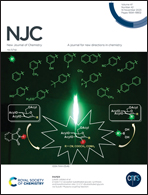A fluorescent sensor for rutin hydrate based on a cyanostilbene macrocycle†
Abstract
Rutin hydrate has some pharmacological properties and is widely available in human food and household samples. Although many methods based on large-scale instruments have been established for the detection of rutin hydrate, a simple, rapid and in situ measurement strategy was rarely reported up to now. In this work, a fluorescent sensor based on the cyanostilbene macrocycle (BCM) was developed for detecting rutin hydrate with high selectivity and sensitivity. BCM is a bis-cyanostilbene macrocycle with a bridging thiourea chain prepared by “1 + 1” condensation in 75% yield. BCM possessed a good fluorescence emission at 475 nm with an absolute fluorescence quantum yield of 0.26 in DMSO–H2O (5 : 95). It exhibited good selective detection for rutin hydrate among a series of normal ions and biomolecules with a “turn-off” fluorescence response. The binding constant of BCM for rutin hydrate was 2.4 × 104 M−1 and the detection limit attained 1.16 × 10−7 M. The 1 : 1 sensing mechanism was clarified using Job's plot, and 1H NMR and MS binding spectra. The sensing ability of BCM for rutin hydrate was successfully applied in detecting rutin hydrate in a test paper, three fruits and experiments of standard addition recovery with the recoveries of 90–95%, implying the simple, rapid and in situ detecting potential of BCM for rutin hydrate in real samples and the environment.



 Please wait while we load your content...
Please wait while we load your content...